Saint Demetrius of Thessaloniki Greece
.jpg)
St. Demetrius by Manuel Panselinos in the Church of Protaton on Mount Athos (circa 1290 AD)
Saint Demetrius, patron Saint of Thessaloniki, was a Christian martyr born into an aristocratic family of the Roman province of Macedonia in 270 AD.
He is one of the most popular saints of the Greek Orthodox Church and an important military or warrior saint.
He is often paired with Saint George, another much-loved military saint.
The Feast Day of Saint Demetrius is celebrated on 26 October.
Despite his high military position in the Pagan Roman army during the Great Persecution of Christians, 303-313 AD Saint Demetrius remained a faithful Christian and converted many Pagans to the Christian faith.
The imprisonment of Saint Demetrius
Jealous of Demetrius’ successful life, or more likely because of the fact he was a Christian, the pagans threw him into prison, which happened to be an old, unused Roman bath.
Whist he was imprisoned, Demetrius was visited by Nestor, a fellow Christian.
Nestor had just challenged one of the fiercest Roman gladiators, Lyeios, to a duel in protest for his terrible torment of Christians and thought it prudent to ask for the blessing of Demetrius, before entering the arena.

Saint Demetrius, blessing Saint Nestor
The deaths of Demitrius and Nestor
Against all odds, Saint Nestor, slayed the Roman gladiator, Lyeios.
This resulted in the Emperor, Maximian first beheading Saint Nestor outside the city and then having Saint Demetrius impaled in Prison.
Maximian even had Saint Demetrius’ slave, Lupus behead for using the blood-stained tunic and ring of his master, to work miracles.
The Christians buried Demetrius and Nestor side by side in the unused Roman bath, where Demetrius had been imprisoned and executed.

Crypt of Saint Demetrius, in the church dedicated to the martyr. According to tradition, this is where Demetrius was imprisoned, put to death and buried.
The feast Day of Saint Nestor, is celebrated, one day after the Feast Day of Saint Demetrius (26 October) on 27 October.
In the seventh century, a miraculous flow of myrrh was said to be seeping from the tomb of Saint Demetrius, giving rise to the name; Saint Demetrius “Mirovlitis”, Saint Demetrius the Myrrh Streamer.

Relics of Saint Demetrius, a Military Saint at the Hagios Demetrius Basilica, Thessaloniki
The Miracles of Saint Demetrius
Also in the seventh century AD, a book, “The Miracles of Saint Demetrius” in Latin “Miracula Sancti Demetri”, were compiled telling of the miracles of Saint Demetrius of Thessaloniki.
The book is divided into two volumes, the first, written by John, Archbishop of Thessaloniki (610-620), describes miracles attributed to Saint Demetrius.
Fifteen miracles are mentioned in the first volume of “Miracles of Saint Demetrius” including the intervention of the Saint, during the siege of Thessaloniki, (Known as the invasion of the Slavs), and how the Saint saved the city from the plague.
The second volume written sometime around 680, by an unknown author is mostly an historic account of Saint Demetrius.
Both volumes were publicly read to the citizens of Thessaloniki.
The Church of Saint Demitrius.
Haigos Demetrius
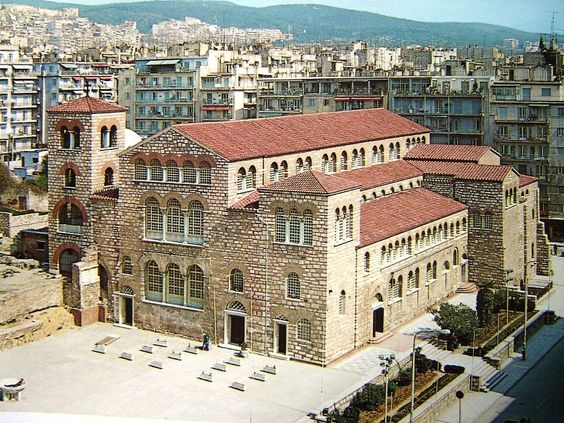
The Church of Hagios Demetrius, is the main sanctuary dedicated to Saint Demetrius, the patron saint of Thessaloniki
The first church of Saint Demetrius was built in Thessaloniki, the second largest city of The Byzantine Empire after Constantinople early in the fourth century AD, on the site said to be the spot where Saint Demetrius was imprisoned and executed in an unused Roman bath.
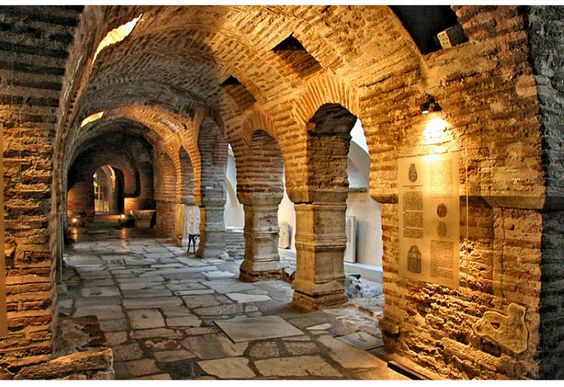
Catacombs of Saint Demetrius, Thessaloniki, the church is believed to be built, the site of the old Roman baths, where Saint Demetrius was executed.
It was the most important and largest shrine in the city, larger than the local Cathedral (Site unknown).
A century later, Leondis, a regional governor replaced the small oratory (A room for prayer) with a larger, three-aisled basilica (A building for public worship).
The church which was repeatedly destroyed by fire was eventually rebuilt as a five- aisled basilica in 629-634.
The ciborium of The Church of Saint Demetrius Thessaloniki
The Church of Saint Demetrius in Thessaloniki contains an unusual shrine; The ciborium an hexagonal roofed construction located at the side of the nave.
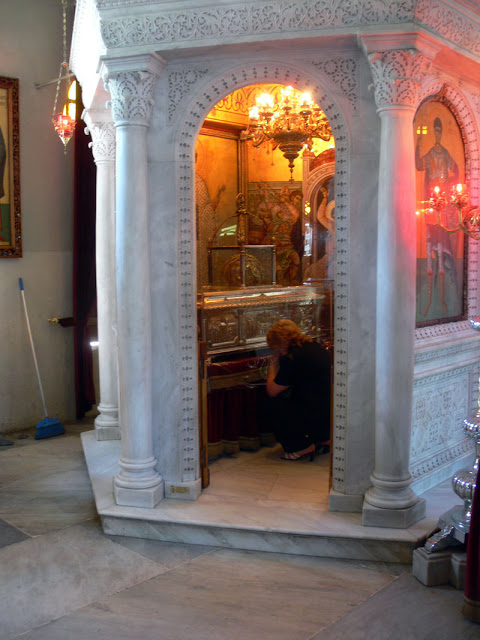
Small shrine inside the church, containing the remnants of St. Demetrius
Inside the ciborium is a bed and although it is believed that for four centuries after the Saint’s death, it contained no relics, it seemed to have been a symbolic tomb of Saint Demetrius.
This ciborium has been rebuilt at least once.
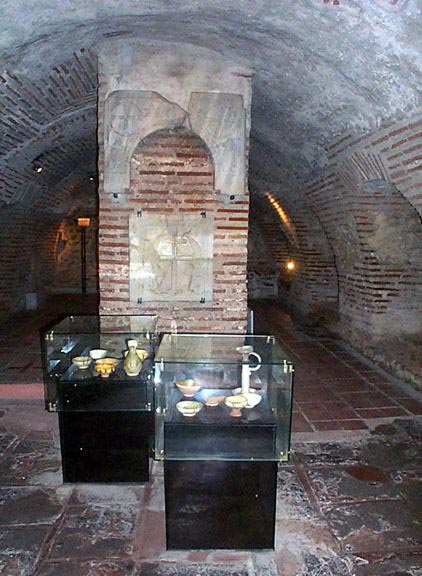
The remains of the original ciborium. Photo vlass2000
The mosaic panels of The church of Saint Demetrius Thessaloniki
The church of Saint Demetrius in Thessaloniki is famous for six mosaic panels depicting Saint Demetrius, together with the officials responsible for the church’s restoration and with children.
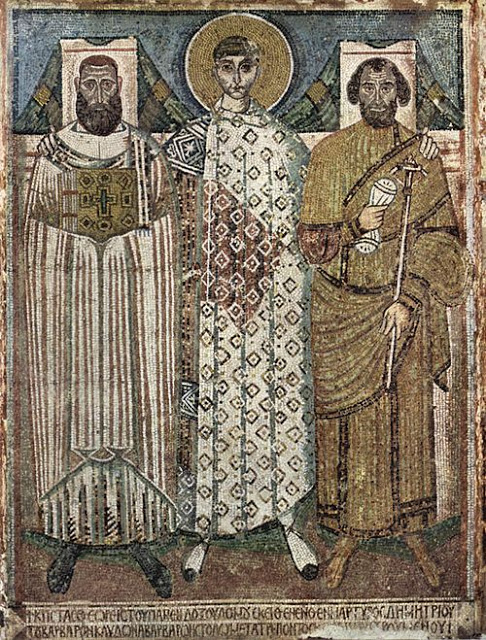
Saint Demetrius with Archbishop John and regional governor,Leondis , Thessaloniki, mosaic, 650
These mosaic panels are rare examples of Byzantine art which have survived from the Dark Ages following the reign of the Byzantine Emperor Justinian (527-565 AD).
Saint Demetrius with children, one of very few Byzantine mosaics that escaped destruction from the hands of the iconoclasts.
Other magnificent mosaics (recorded as decorating the interior of the church) have been lost, either during the four centuries when the church functioned as a mosque, under Ottoman rule (1493-1912), or in “The Great Fire of Thessaloniki” in 1917 which destroyed most of the city.
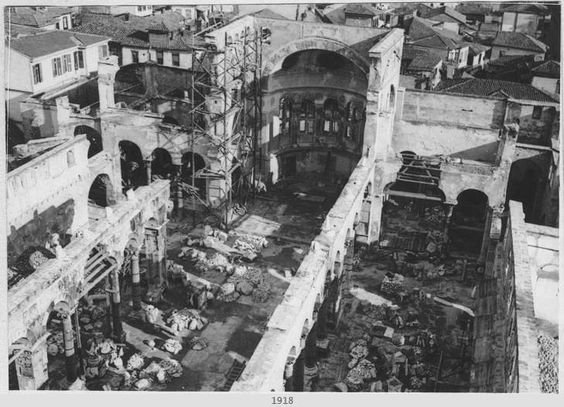
Saint Demetrius Church, after ” The Great Fire of Thessaloniki” 1917
It took decades to rebuild the church after the great fire and during the excavations a Roman bath was discovered believed to be the place where Saint Demetrius was held prisoner and later executed.
A Roman well was also discovered during reconstruction of the church, thought to be the well, into which Roman soldiers threw Saint Demetrius’ body, after his death.
The fountain, in the crypt of Saint Demetrius Church, Thessaloniki. Believed to be the well, into which the Romans threw the body of the Saint.
The rebuilding of The Church of Saint Demetrius of Thessaloniki was finally finished and the church re-consecrated in 1949.
The church is now part of the Palaeochristian site and Byzantine Monuments of Thessaloniki and was added to the list of World Heritage Sites by UNESCO in 1988.
Related links:
Saints and Celebrations of the Greek Orthodox Church



